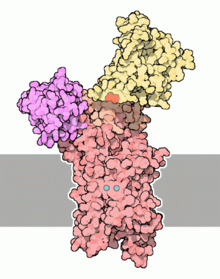Calcium ATPase
| Calcium ATPase | |||||||||
|---|---|---|---|---|---|---|---|---|---|
 Calcium ATPase[1] | |||||||||
| Identifiers | |||||||||
| EC no. | 3.6.3.8 | ||||||||
| Databases | |||||||||
| IntEnz | IntEnz view | ||||||||
| BRENDA | BRENDA entry | ||||||||
| ExPASy | NiceZyme view | ||||||||
| KEGG | KEGG entry | ||||||||
| MetaCyc | metabolic pathway | ||||||||
| PRIAM | profile | ||||||||
| PDB structures | RCSB PDB PDBe PDBsum | ||||||||
| |||||||||
Ca2+ ATPase is a form of P-ATPase that transfers calcium after a muscle has contracted. The two kinds of calcium ATPase are:[2]
- Plasma membrane Ca2+ ATPase (PMCA)
- Sarcoplasmic reticulum Ca2+ ATPase (SERCA)
Plasma membrane Ca2+ ATPase (PMCA)

Plasma membrane Ca2+ ATPase (PMCA) is a transport protein in the plasma membrane of cells that serves to remove calcium (Ca2+) from the cell. It is vital for regulating the amount of Ca2+ within cells.[3] In fact, the PMCA is involved in removing Ca2+ from all eukaryotic cells.[4] There is a very large transmembrane electrochemical gradient of Ca2+ driving the entry of the ion into cells, yet it is very important for cells to maintain low concentrations of Ca2+ for proper cell signalling; thus it is necessary for the cell to employ ion pumps to remove the Ca2+.[5] The PMCA and the sodium calcium exchanger (NCX) are together the main regulators of intracellular Ca2+ concentrations.[4] Since it transports Ca2+ into the extracellular space, the PMCA is also an important regulator of the calcium concentration in the extracellular space.[6]
The PMCA belongs to a family of P-type primary ion transport ATPases that form an aspartyl phosphate intermediate.[4]
The PMCA is expressed in a variety of tissues, including the brain.[7]
Sarcoplasmic reticulum Ca2+ ATPase (SERCA)
SERCA resides in the sarcoplasmic reticulum (SR) within muscle cells. It is a Ca2+ ATPase that transfers Ca2+ from the cytosol of the cell to the lumen of the SR at the expense of ATP hydrolysis during muscle relaxation.
See also
References
- ^ PDB Molecule of the Month Calcium pump
- ^ nlm.nih.gov
- ^ Jensen TP, Buckby LE, Empson RM (September 2004). "Expression of plasma membrane Ca2+ ATPase family members and associated synaptic proteins in acute and cultured organotypic hippocampal slices from rat". Brain Research. Developmental Brain Research. 152 (2): 129–36. doi:10.1016/j.devbrainres.2004.06.004. PMID 15351500.
- ^ a b c Strehler EE, Zacharias DA (January 2001). "Role of alternative splicing in generating isoform diversity among plasma membrane calcium pumps". Physiological Reviews. 81 (1). American Physiological Society: 21–50. doi:10.1152/physrev.2001.81.1.21. PMID 11152753.
- ^ Carafoli E (January 1991). "Calcium pump of the plasma membrane". Physiological Reviews. 71 (1): 129–53. doi:10.1152/physrev.1991.71.1.129. PMID 1986387.
- ^ Talarico EF, Kennedy BG, Marfurt CF, Loeffler KU, Mangini NJ (March 2005). "Expression and immunolocalization of plasma membrane calcium ATPase isoforms in human corneal epithelium". Molecular Vision. 11: 169–78. PMID 15765049.
- ^ Jensen TP, Filoteo AG, Knopfel T, Empson RM (February 2007). "Presynaptic plasma membrane Ca2+ ATPase isoform 2a regulates excitatory synaptic transmission in rat hippocampal CA3". The Journal of Physiology. 579 (Pt 1): 85–99. doi:10.1113/jphysiol.2006.123901. PMC 2075377. PMID 17170045. 17170045. Archived from the original on September 27, 2007.
{{cite journal}}: Unknown parameter|deadurl=ignored (|url-status=suggested) (help)
External links
- Calcium+ATPase at the U.S. National Library of Medicine Medical Subject Headings (MeSH)
- EC 3.6.3.8
- Overview at utoronto.ca
- Cation transporting ATPase family in Pfam
